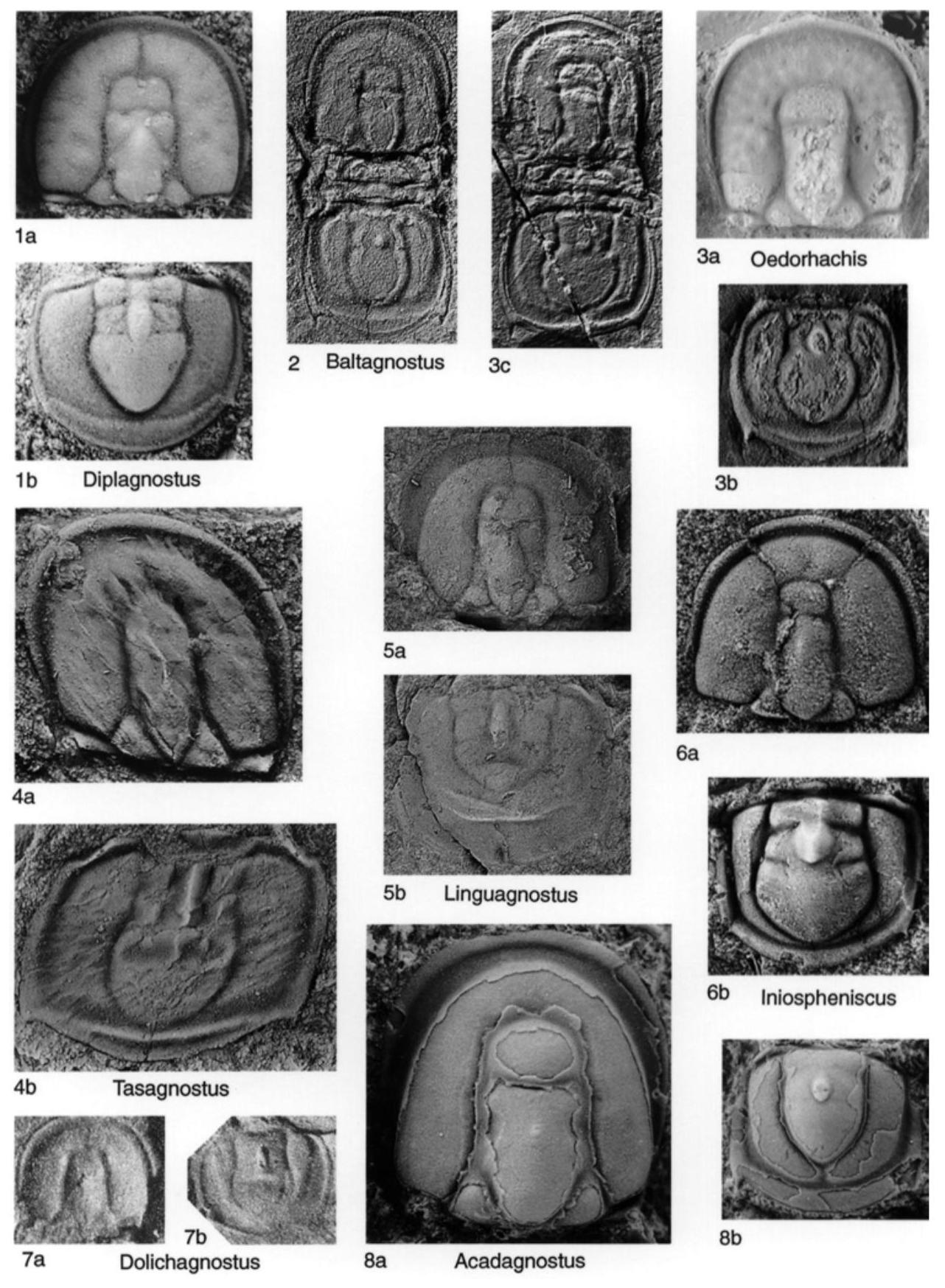Welcome to the Treatise on Invertebrate Paleontology!
Please enter a genera name to retrieve more information.

Linguagnostus
Classification
Phylum:
Arthropoda
Class:
Trilobita
Order:
Agnostida
Superfamily:
Agnostoidea
Family:
Diplagnostidae
Formal Genus Name and Reference:
Linguagnostus KOBAYASHI, 1939a, p. 142
Type Species:
Agnostus kjerulfi Brögger, 1878, p. 65, OD, lectotype (SD WESTERGÅRD, 1946, p. 124, pl. 8, fig. 32), 28684, PMO, Oslo
Images
(Click to enlarge in a new window)
Fig. 230,5a,b. *L. kjerulfi (B RÖGGER ), Middle Cambrian (Paradoxides forchhammeri beds), Norway (Krekling, Oslo district); a, paralectotype, cephalon, PMO 28682, ×5.5; b, lectotype, pygidium, PMO 28684, ×5.5 (new).
Synonyms
Geographic Distribution
Sweden, England, P. punctuosus Zone; Denmark, P. davidis Zone; Norway, P. forchhammeri Zone; Wales, P. paradoxissimus Zone; Russia (Siberia, Tuva), Turkestan Mountain Range, Tadzhikistan; Kazakhstan, L. laevigata, Anopolenus, L. allachjunensis Zones; China (Hunan, Guizhou, Qinghai, Zhejiang), L. armata Zone; Australia (Queensland, Northern Territory), T. gibbus to L. laevigata Zones.
Age Range
Beginning Stage in Treatise Usage:
upper Middle Cambrian
Beginning International Stage:
Drumian
Fraction Up In Beginning Stage:
0
Beginning Date:
504.5
Ending Stage in Treatise Usage:
upper Middle Cambrian
Ending International Stage:
Guzhangian
Fraction Up In Ending Stage:
50
Ending Date:
498.75
Description
Nonscrobiculate, deliquiate border furrows, zonate pygidial border, pygidial acrolobe commonly constricted, median preglabellar furrow absent, Glabella with trapeziform to subrectangular anterior lobe, commonly with median sulcus, F3 clearly impressed, F2 weakly developed or absent, glabellar culmination narrowly rounded or angular, glabellar node about level with F2 furrows, Pygidium bispinose or trispinose, commonly with postaxial notch on margin, axis short, broadly ogival, unconstricted or slightly constricted across M2, F1 effaced to clearly impressed laterally, F2 effaced to clearly impressed, posterior lobe short, broad, subtriangular, with transverse depression at about midlength, Pygidial collar sinuous, extending onto acrolobe.
References
Museum or Author Information
Classification
Phylum:
Arthropoda
Class:
Trilobita
Order:
Agnostida
Superfamily:
Agnostoidea
Family:
Diplagnostidae
Formal Genus Name and Reference:
Linguagnostus KOBAYASHI, 1939a, p. 142
Type Species:
Agnostus kjerulfi Brögger, 1878, p. 65, OD, lectotype (SD WESTERGÅRD, 1946, p. 124, pl. 8, fig. 32), 28684, PMO, Oslo
Images
(Click to enlarge in a new window)
Fig. 230,5a,b. *L. kjerulfi (B RÖGGER ), Middle Cambrian (Paradoxides forchhammeri beds), Norway (Krekling, Oslo district); a, paralectotype, cephalon, PMO 28682, ×5.5; b, lectotype, pygidium, PMO 28684, ×5.5 (new).
Synonyms
Geographic Distribution
Sweden, England, P. punctuosus Zone; Denmark, P. davidis Zone; Norway, P. forchhammeri Zone; Wales, P. paradoxissimus Zone; Russia (Siberia, Tuva), Turkestan Mountain Range, Tadzhikistan; Kazakhstan, L. laevigata, Anopolenus, L. allachjunensis Zones; China (Hunan, Guizhou, Qinghai, Zhejiang), L. armata Zone; Australia (Queensland, Northern Territory), T. gibbus to L. laevigata Zones.
Age Range
Beginning Stage in Treatise Usage:
upper Middle Cambrian
Beginning International Stage:
Drumian
Fraction Up In Beginning Stage:
0
Beginning Date:
504.5
Ending Stage in Treatise Usage:
upper Middle Cambrian
Ending International Stage:
Guzhangian
Fraction Up In Ending Stage:
50
Ending Date:
498.75
Description
Nonscrobiculate, deliquiate border furrows, zonate pygidial border, pygidial acrolobe commonly constricted, median preglabellar furrow absent, Glabella with trapeziform to subrectangular anterior lobe, commonly with median sulcus, F3 clearly impressed, F2 weakly developed or absent, glabellar culmination narrowly rounded or angular, glabellar node about level with F2 furrows, Pygidium bispinose or trispinose, commonly with postaxial notch on margin, axis short, broadly ogival, unconstricted or slightly constricted across M2, F1 effaced to clearly impressed laterally, F2 effaced to clearly impressed, posterior lobe short, broad, subtriangular, with transverse depression at about midlength, Pygidial collar sinuous, extending onto acrolobe.
